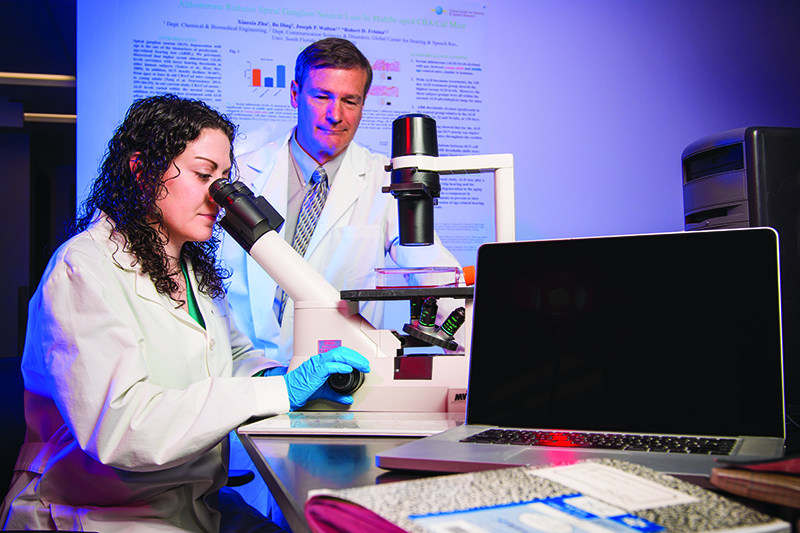College of Engineering News Room
Grant Will Fund Hearing Loss Research

By Brad Stager
Losing even some hearing ability can have a large impact on a person’s life and thanks to funding from the American Hearing Research Foundation, researchers at the University of South Florida will investigate whether the relationship between hearing loss and a common nutritional supplement can lead to therapies that can treat one type of deafness.
The AHRF has awarded $62,970 to Research Assistant Professor Parveen Bazard of USF’s Global Center for Hearing and Speech Research as a recipient of its Richard G. Muench Chairman’s Grant.
The grant addresses the problem of presbycusis, or age-related hearing loss, which is a major medical concern that is growing as the population of older people increases.
According to the National Institute on Deafness and Other Communication Disorders, about a third of the people in the United States between the ages of 65 and 74 have hearing loss, with almost 50 percent of people older than 75 experiencing hearing difficulty. The institute asserts hearing loss can be a factor in problems such as having an increased risk for accidents or experiencing greater social isolation.
There are no effective treatments currently available for ARHL and Bazard’s study is a pre-clinical investigation into the potential for a nutritional amino acid to treat and prevent loss of hearing resulting from aging.
Bazard, who received his PhD in chemical and biomedical engineering from USF in 2017, has worked at the cellular level to develop treatment protocols and systems such as biosensors that can yield information about chemical and electrical activity in the human body or deliver drugs with greater precision. To conduct this kind of research, he calls upon his knowledge and skills in areas such as nanoparticle synthesis, materials, data analysis, and in-vitro cell physiology.
The multidisciplinary nature of Bazard’s research is reflected in the involvement of diverse USF entities such as the GCHSR, the Department of Medical Engineering and the Department of Communication Sciences and Disorders. He credits easy access to needed resources, such as a laser scanning confocal microscope to study biomarkers, as instrumental in his success. Bazard also cites the support of those he works with as being essential in the search for solutions to hearing problems.
“In addition to our noteworthy research facilities, I have fantastic mentors, Dr. Robert Frisina, and our productive team which includes doctors Bo Ding, Xiaoxia Zhu, Mark Bauer, and two student lab assistants, Lina Elessawy and Nidhi Bangalore for this project.” Professor Frisina is chair of USF’s Department of Medical Engineering and is GCHSR’s director. Professors David Eddins and Joseph Walton of the USF Department of Communication Sciences and Disorders are associate directors of GCHSR.
The GCHSR is a renowned research facility that brings together resources of USF’s College of Engineering and its College of Behavioral and Community Sciences to develop and apply multidisciplinary techniques that address hearing, speech and other sensory deficits affecting people.
Research at GCHSR is conducted at the intersection of communication sciences and biomedical engineering with an emphasis on sensory impairments and disorders, particularly in the auditory realm.
Besides raising the profile of USF’s standing as a place where innovative and beneficial research occurs, GCHSR serves as a resource that fosters mentorship of students and encourages entrepreneurship in applying knowledge developed within its laboratory spaces.
For Bazard, who is a research assistant professor of GCHSR, the grant represents an opportunity to develop solutions to a medical problem that afflicts a lot of people, in many ways.
“This grant is focused on developing therapeutics for age-related hearing loss, the top communication disorder of our aging population, affecting most people above the age of 55 to 60 years,” said Bazard.
“Currently, there is no FDA approved drug for treatment or prevention. ARHL also contributes to other problems such as loss of economic productivity, loneliness, declines in independence, and is even linked to cognitive decline and dementia with age.” Bazard adds that the techniques developed in this research could have applications in other neurodegenerative disease and sensory deficit-related research.
As part of the research, the amino acid ergothioneine, found in foods such as mushrooms, will be administered to laboratory animals to evaluate its effectiveness in mitigating ARHL. Ergothioneine is widely available to consumers as a nutritional supplement and is thought to have antioxidant properties.
Investigating the effectiveness of therapeutic substances derived from food sources, sometimes known as nutraceuticals, is an approach that Bazard hopes will yield a low-cost, easily administered treatment that will help reverse the increasing incidence of hearing loss and improve peoples’ lives.
“The use of ergothioneine has never been investigated for hearing protection,” said Bazard. “If successful, our new findings could translate to clinical practice without delay. We hope that this compound can be part of a comprehensive plan to improve hearing and sensory function in general, for our aging population.”